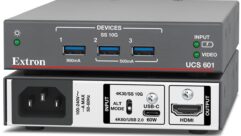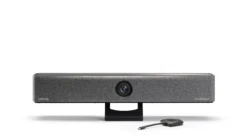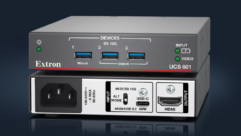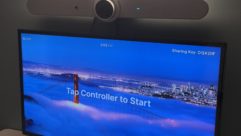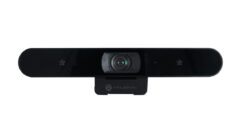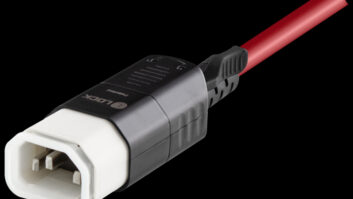
Huddle Rooms: Huddle Spaces
Nov 12, 2014 3:24 PM,
Frost & Sullivan, Excerpted courtesy of Biamp Systems
While many companies have succeeded at deploying and using unified communications and collaboration (UCC) on the desktop, and even more leverage audio and videoconferencing in large conference rooms, few have managed to extend state-of-the-art collaboration capabilities to small group spaces.
These so-called “huddle rooms” are where most real collaboration gets done: small teams working together in person and with their remote colleagues to make decisions, drive projects, and increase productivity throughout the organization.

To make the most of these work-style opportunities, companies must look at huddle rooms not as small conference rooms, but rather as extensions of the desktop—where advanced communication and collaboration capabilities can enable deep, iterative interaction.
At the dawn of the 21st century, large conference rooms enabled collaboration better than desktop PCs. This was largely due to the high cost of bandwidth and services, inconsistent quality of VoIP services, and inconsistent desktop standards leading to poor-quality applications. But desktop capabilities have quickly caught up. Web conferencing platforms added functionality, including softphones, HD audio and video, chat, team spaces, and presence information. As the costs of bandwidth, applications, and services have decreased, more users are turning to the desktop for day-to-day collaboration.
But that shift leaves small groups with nowhere to go. Traditional conference rooms—replete with expensive audio/video systems–are generally reserved for large groups, and many companies are eliminating these larger spaces in favor of open-office design. Further, desktop and notebook PCs don’t easily accommodate more than one user at a time, especially in these open offices. The solution: huddle spaces—meeting rooms, offices, and gathering sites that can offer high-quality audio and video equipment while running the same desktop services and applications employees are used to. This ensures a professional experience for all meeting participants, without sacrificing the discrete and increasingly important collaboration capabilities today’s successful businesses require.
A recent Frost & Sullivan survey of more than 1,000 IT decision- makers in the US and Europe reveals that more than one-third of employees are either mobile (working primarily from the road) or remote (working mainly from a home-based office and/or client sites). In order for them to stay connected with one another—as well as their far-flung business partners and customers— they must leverage technology that lets them interact in real time, mark up documents, and share screens or applications.
Frost & Sullivan research also shows that collaboration is top-of- mind for today’s IT and line-of-business managers, and that’s reflected in the types of technologies they deploy to their employees. In the same survey, 47 percent of respondents say they use web conferencing at the desktop. Additionally, this trend is expected to continue as many of the respondents who don’t currently use web conferencing expect to deploy it in the next three years. With so many web conferencing tools incorporating audio and video capabilities—and with so many employees working on mobile devices—it’s increasingly the case that these desktop environments offer more robust meeting capabilities than most conference rooms.
Indeed, in some situations, using a web conferencing platform can make meetings more productive than the traditional, in-person counterpart. Web sessions allow users to work on files together and then save the most recent versions. Participants can chat in small groups or with all participants. They can conduct polls, ask questions, and even record the entire session for later review.
The trick now is finding a way to extend those capabilities into small-group meetings without introducing yet another user interface or making another investment in conferencing software and services.
EXTENDING THE DESKTOP TO SMALL GROUPS
Although many businesses have invested in large-group conference rooms, the reality is that most work gets done by small teams. One might imagine three to six people working together to flesh out a new idea, launch a new marketing campaign, or develop a new product or service. Frost & Sullivan research shows that companies are moving in this direction, too. More organizations are carving out small meeting rooms from existing spaces by converting executive offices, large supply closets, and open bullpens into gathering spaces where a half-dozen employees can collaborate on projects.

These small spaces make it easy for small groups to convene, but they don’t typically come outfitted with a full suite of unified communications and collaboration (UCC) technology. And yet, it’s those very applications and services that can turn an unproductive meeting into a successful collaboration session, with clear action items and deliverables as the result.
Still, no one wants to deploy yet another set of applications and services for a specific use case or meeting environment, especially given how much users prefer the tools they are already familiar with and have at their desks. (The same Frost & Sullivan research shows that IT decision-makers are generally satisfied with their UCC solutions, with as many as two-thirds of them rating video conferencing as highly effective, and more than half saying the same for web conferencing.) As a general rule, it is far better to standardize on one platform for all users in all use cases than to offer a different application or service for every meeting environment.
Indeed, Frost & Sullivan recommends that as huddle rooms are created, companies should deploy hardware that will easily and cost-effectively support the software already in use. The idea is to bring the desktop to the conference room. By using industry standard connectivity, such as USB or HDMI in the group space, organizations can create a clean pass-through to professional-grade audio, video, and data-sharing capabilities directly from employees’ devices. Instead of crowding around a small PC screen, meeting participants can see their web and video applications on a large wall-mounted display, and benefit from an audio conferencing system that delivers clear, crisp sound—without having to get used to a whole new UCC environment.
In some cases, attendees will actually carry the meeting from their physical desk or cubicle into a huddle space, connecting their PC or tablet device to the professional-grade hardware without dropping the call or losing fidelity. More people can be invited into a meeting as needed, both virtually and in person. And meeting participants can take advantage of all the capabilities desktop web and video conferencing offer, without having to learn a new interface.
This technique also allows a company to effectively “future-proof” its UCC platform; since huddle rooms contain standards-based hardware that can instantly support any software or service, managers don’t need to worry about what introducing the latest-and-greatest technology will do to their infrastructure—it just works.
This is especially important today, as UCC vendors expand into WebRTC and other advanced standards and capabilities for their platforms. And, of course, companies that leverage the bring-your-own-technology trend—or allow individual business units to choose the web and videoconferencing services they prefer— can confidently incorporate those applications knowing that they will work with the deployed hardware within the huddle room.
Best of all, extending desktop apps to huddle rooms improves return on investment. This is true for the rooms themselves, which will see more use as employees realize they can use their familiar UCC applications in a comfortable, productive environment; UCC tools also will see more use, as employees apply them in small-group discussions for which in the past they might have relied on audio-only conferencing or nothing at all.
While UC has generally been successful on the desktop, companies have failed to translate that functionality to small group spaces, or huddle rooms. But huddle rooms are not just small conference spaces. Rather, they should be seen as a large desktop.
A connected desk offers web conferencing, softphone connectivity, screen and application sharing, team rooms, and social tools designed to drive collaboration and increase successful communication. A unified desktop goes even further to deliver enterprise UC solutions, such as Microsoft Lync, that deliver a robust UC stack, including voice, video, data, presence, and mobility.
When companies extend that desktop functionality to huddle rooms, they make it easy for employees to access multi-codec telepresence; fully installed, professional-grade audio; and dedicated screens for effective data and application-sharing. By using standards-based hardware, businesses ensure their investment will last well into the future, supporting new technologies like WebRTC. The result is more productive and effective meetings, and a clear return on investment.


